The village is even more attractive in summer than it is in winter, and just as energetic – swapping challenging skiing for ridge-top hikes, steep MTB trails and rock climbing. But if you’re not looking for extreme adventure you’ll find plenty for families to do, too.
Altitude: 1304m
Lifts open in summer: 4 gondolas, 2 chair-lifts
Walking trails: 300km
Cycle paths: 350km mountain bike trails and 350km road cycling trails
Lift pass: unlimited use with a three day Premium Card costs €55.
Official Site
Essential Advice for the Perfect Holiday
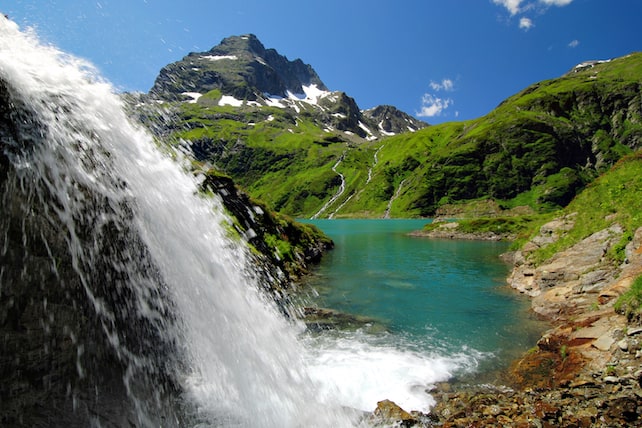
St Anton in summer has much the same atmosphere as in winter. It’s a lively, picturesque village full of people in love with energetic mountain sports. But instead of skiing and snowboarding, they’ve come to hike, bike, climb and run.
This is not sort of place you’ll find hordes of tourists mooching about in designer boutiques and snacking on pastries (although both are possible in St Anton). Instead, the pretty, pedestrianised streets are buzzing with hyperactive families, lean, wiry twentysomethings and well-maintained older couples – all kitted out in the latest technical clothing and carrying ergonomic backpacks rather than shopping bags. They’re here to drink in the dramatic mountain scenery and pit themselves against its steep terrain.
Increasingly, they’ll gather for a summer festival, too. Each July the town hosts the Arlberg Giro with up to 1,500 cyclists competing on the 150km course. Meanwhile, at the end of August the annual Mountain Yoga Festival is becoming an important event.
St Anton is 100km by road from Innsbruck and there’s a mainline railway station in the centre, served by fast trains from Zurich, Munich and Innsbruck. In fact, the train journey from UK is straightforward, and can be done in about 13 hours (book in advance for cheaper Sparschiene fares from the ÖBB). Then, once you arrive you’ll find St Anton is one of the Alps’ most sustainable resorts, thanks to its own hydroelectric power station, which uses water from the Kartellsee reservoir, and generates around 33 million kilowatt hours of electricity a year. That’s more than enough for the resort’s own needs.
Once you’re in the resort there’s no need for a car. As well as the uplift provided by the resort’s mountain gondolas, chairlifts and cable cars, local buses connect all the most important sights – including the beautiful Verwall lake, the villages of St Christoph, Lech, Zurs and Pettneu, and the town of Landeck.
Where to Walk
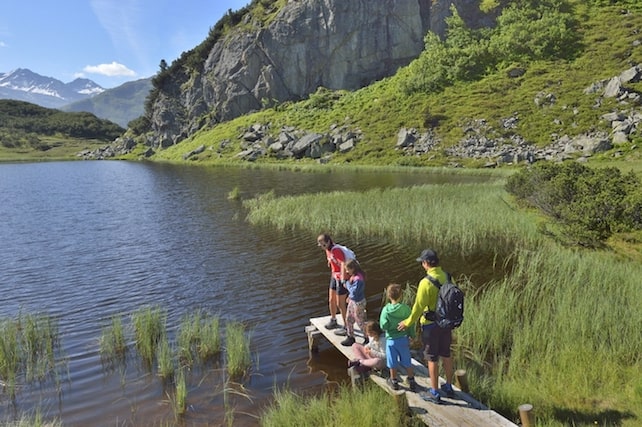
The resort publishes an excellent Hiking Guide complete with 49 different routes, each with a detailed description, map, topographic profile, and colour picture. They range from a one-hour stroll to a ten-hour high alpine tour. An interactive map can be found online.
The Arlberg is famous for its varied flora, including enzian, edelweiss, medicinal herbs, and 25 kinds of orchids, so it’s no wonder its walking tours include several ‘alpine flower hikes’. One such hike starts by going across the field to the outlying ski hamlet of Nasserein before continuing through the forest to Putzenalpe. It then descends to St Jakob before heading back to St Anton again – the walking time is about five hours. Another, the Alpen Rose Way, is a 18.5km celebration of the Arlberg’s dwarf rhododendrons.
There’s a pleasant family hike called Mutspuren, reached by the Galzig cable-car then walking the paths around Galzig before taking the lift back down again. En route are inter-active displays such as old skis you can try on, and other themed exhibits – everything made from natural wood, nothing plastic – for learning and playing as you go. A longer version is to walk via Maiensee and the Sennhütte back down to St Anton.
Another easy walk is around the Verwall Lake, reached by one of the free local buses. There’s a completely renovated children’s play area on the northern shore, and a restaurant – the Rasthaus Ferwall (+43 664 2424201) – at the end of the lake, offering tasty food. You can take the bus or one of the walking routes back to the village afterwards. The winter cross-country track transforms into a 40km-long route that’s ideal for parents with buggies.
For something more challenging, try the Mountain Spirit trail that begins in the nearby village of St Christoph (there’s a bus from St Anton).
The hike begins with a steep ascent, but then flattens out a bit above St Christoph, with spectacular views. The route leads on to the Kaltenberghutte, which is an ideal place to stop for lunch. You then return down the Stuben side of the mountain and back to St Christoph.
Another dramatic walk, with stupendous views, is the 10km circuit, via Kappal, that takes in the Leutkircher Hut. It follows part of the famous 413km Adlerweg trail through the Tirol and the East Tirol.
Children will love the Wonder Walking Trail at the Senn Hutt, where they can find out what grows in the forest and myriad other interesting facts. There are guided nature expeditions from Monday to Friday for kids aged four to 16 years, teaching them how to build a dam or construct a sundial.
St Anton also has Nordic walking try-out courses and tours, all with instruction on offer.
Mountain Biking and Road Cycling
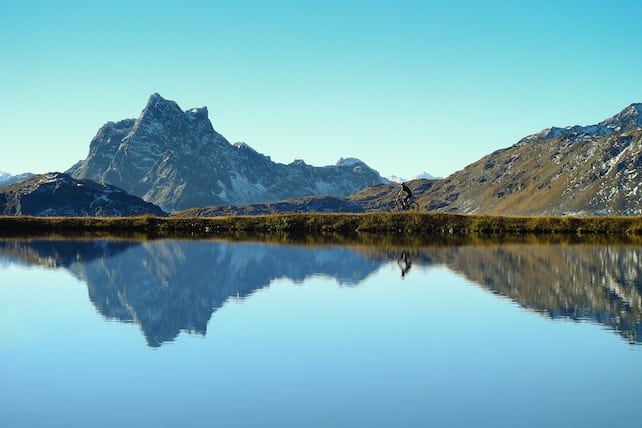
St Anton is one of the Tirol’s leading cycling regions, with a 350-km network of signposted tracks, along with a good mountain bike network of around 200 kilometres. There is something for every type of mountain biker: from easy paths through woods and meadows, through gentle climbs to steep routes for hardcore enthusiasts.
The newly extended Eldorado Bike-Areal Verwall features the Pump Track, which is designed to be ridden by riders using up-and-down body movements – enabling the entire track to be completed without using pedals.
You’ll also find the Northshore Trail here, which is a circuit of banked turns and natural obstacles such as tree trunks and stones through the forest. There is a separate children’s obstacle course, where younger riders can have their first experience of overcoming a number of obstacles.
The Rendlbahn transports bikes free of charge. All routes begin at the ARLBERG-well.com sports and wellness centre and are signposted. If you want to try e-biking there are daily tours with a variety of trails and destinations. Kids from 10 years old can join the guided tours.
The resort alos hosts and e-bike festival every June. In addition to specially designed test tracks and a driving safety area, local guides will be available for e-bike tours.
If you have a competitive streak, you could consider entering the Arlberg Giro, which takes place at the end of July. The circuit starts in St Anton and continuing via Schruns, Gaschurn, Ischgl and Pettneu before ending up in St Anton. The route is 150km long and covers 2400 vertical meters. The Pro Cycle Criterium takes place the day before.
Other Activities: From Watersports to Yoga
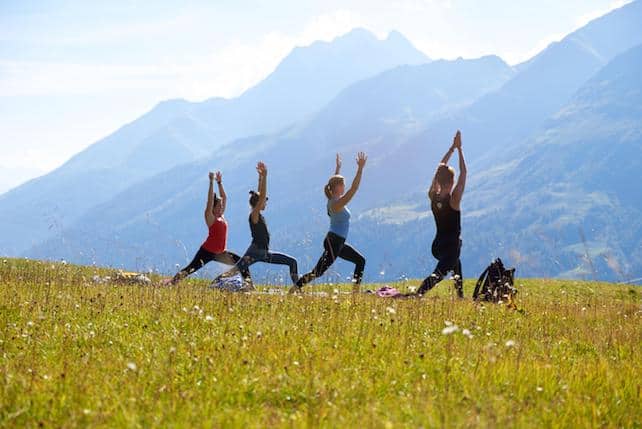
Hotels and other accommodation offer a free Summer Card for the whole of your stay. This includes early-morning yoga sessions on the mountain, archery and e-biking, buses between Landeck and St Christoph, and one day’s use of St Anton’s cable-cars. For a fee, the card can be upgraded to premium for yet more offers.
Other summer sports on offer include paragliding, white water rafting, kayaking and canyoning – the the water sports can be arranged by H2O Outdoor Adventures, which has tours for beginner to extreme level. Family canyoning outings include the three-hour Pirates Dream along a gorge, with a first chance to experience rocks and ropes.
St Anton hosts an annual Mountain Yoga Festival at the end of August, with a programme of yoga classes, sound therapy, meditation, talks and workshops. A mix of different yoga styles are taught by more than a dozen experienced yoga instructors from America, Germany, Switzerland and Austria.
ARLBERG-well.com is a large wellness centre with an indoor and outdoor swimming-pool, a spa with saunas and treatment rooms, outdoor tennis courts, a summer curling alley, and a fitness studio. There’s another indoor swimming-pool, along with a spa, sun terrace and café/restaurant at Wellnesspark Arlberg Stanzertal in nearby Pettneu. Several of the hotels in town have their own indoor pools and there are 11 children’s playgrounds in the area including one at the top of each gondola station.
The Arlberg Golf Club in Nasserein has a nine-hole course for experienced golfers, and there’s another nine-hole course at nearby Lech.
The modern new sports and climbing centre arl.park is great for rainy days, with an indoor climbing wall (there’s also an outdoor one), bouldering, two indoor tennis courts, squash, basketball, volleyball, badminton and indoor football on offer. The centre also has an Asian restaurant.
Between mid-June and the end of September, anyone staying in St Anton can fish over a 20km area and two mountain lakes. Brown and rainbow trout can be caught in the Rosanna River and in Verwall lake. There are char in the Verwallsee, down from the Constance lodge.
Climbing and High-Ropes

The via ferrata here is one of the most challenging in the Alps. Set high above the resort, it’s 3km long with a combination of steep rock faces, narrow ledges, and craggy ridges. Full climbing equipment is needed, including a helmet, and less experienced climbers are advised to hire the services of a guide.
The route is reached either from the Vallugagrat cable-car station or from the mountain station of the Kapall chair-lift, and it leads over the Knoppenjochspitze, Lisunspitze, Haizahne and the Weißschrofenspitze, taking four to six hours depending on your climbing skills. A 2000-metre steel cable, 1,050 rope clamps and 500 hooks help ensure safety as you work your way up the rock faces.
For something a little easier, beginners can try the rope gardens six metres above the forest floor at Verwall. There is also a wide range of free climbing opportunities in St Anton, such as the Klettergarten at the Schanner Gorge, with its 40 different routes. The climbing area around the Darmstaedter Hut and the 3148-metre Kuchenspitze Peak includes seven practice courses and 58 routes
A Little Culture and History
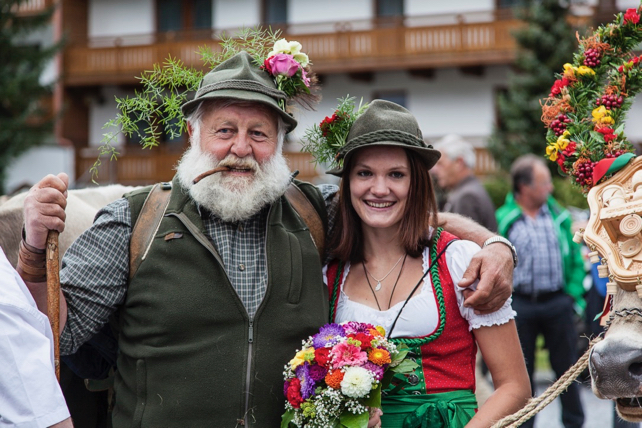
The Museum is well worth a visit to find out all about the resort’s history, which is depicted here with great attention to detail. Old maps, wooden fold-outs with photos of “yesterday” and “today”, winning skis and portraits of great downhill racers are all presented in an interactive way. There are also old films and 3D photos to look at.
If you want to combine the experience with a snack or full meal, you can head to the museum’s restaurant. Treat yourself to a homemade cake and ice cream, smoked trout, Styrian apple juice, or even a gourmet dinner. Up the mountain, four new interactive ‘stations’ provide insights into the myths and legends of the region.
Where to Stay
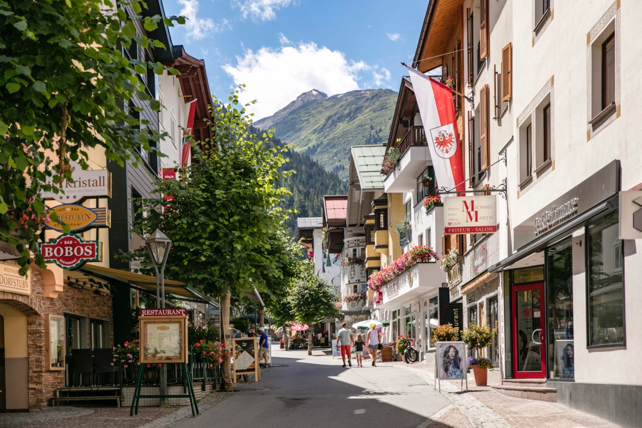
St Anton is divided into three main parts, the town centre (Dorf), Nasserein, and Oberdorf. In winter this makes a difference to where you’re placed for the skiing, but in summer it matters less.
The resort has a lot of cutting-edge accommodation. m3hotel is a four-star minimalist creation in the centre of town, with large bedrooms and en suite bathrooms all equipped with infrared cabins and rainforest showers. In the hotel is the m3cafe with an outdoor terrace, and the excellent m3hazienda-restaurant. In summer there are purpose-built bike facilities in the underground car park, with tools for bike building, repairs and servicing. Meanwhile, the Hotel Arlmont combines comfort with sustainability, thanks to its biomass heating systems and solarpanels on the roof.
Then there’s Raffl’s St Antonerhof, which is a fusion of modern and traditional Austrian design with pale stone floors, oriental rugs, hand-carved furniture and cutting-edge lighting. It has a spa with an indoor swimming-pool.
Hotel Alte Post was the original coaching inn and is steeped in rustic luxury. It has a day spa and in summer the hotel offers a programme of activities including a vintage car tour, a llama trekking tour, e-bike tours, and canyon hiking. Hotel Post, in the pedestrian area, is a good choice for foodies, and has a relaxation centre with an indoor swimming–pool with whirlpool and waterfall, and a sauna area with flower aroma steam bath, saltwater steam bath, Finnish sauna, bio sauna and infrared cabin.
Hotel Banyan is minimalist Asian in character and has an indoor swimming-pool and spa. In summer, pets are allowed, there is a terrace bar, and a bicycle storage room and washing station in the hotel. Centrally-located Hotel Anton is a modern development of apartments and hotel rooms. The interiors are bright and minimalist with the odd incongruous touch, such as old-fashioned rugs on the floorboards. There’s also a spa here.
Right next door is the sleek and modern Skihotel Galzig. The style is modern and minimalist, with a wellness centre and the separate – and nearby – Galzig Lodge containing luxury apartments.
Anthony’s Life & Style Hotel is located in the pedestrian zone and with a hot pink and white colour scheme. The building has a rooftop terrace and open-air whirlpool, and houses Happy Valley steak-house, and Anthony’s pizzeria and pub. Next to the Nasserein gondola is Hotel Reselhof, the oldest Gasthaus in St Anton. It was built in 1490, has attractive bedrooms (unusually, single rooms are also available) and today it has a wellness centre and is run by the Swedish ex-owner of the Krazy Kanguruh bar.
Our favourite is the Himmlhof run by the charming Margarita and Sebastian Penz. Their cosy boutique hotel is located just off the pedestrian zone and offers a delicious breakfast, has a Stubli and lounge for drinks and snacks, and a small spa.
You can also stay in Pettneu, ten minutes’ drive away, with a good choice of accommodation of its own including the Arlberg Life Apartments. These are part of a holiday complex with attractive modern apartments, rooms, restaurants, and a campsite.
Where to Eat
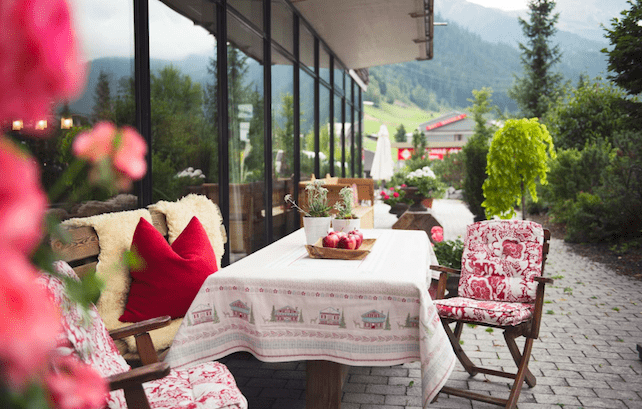
Some 60 bars and restaurants in the village include the friendly Bodega Bar for tapas, and the Grieswirt restaurant which has good food and a nice terrace overlooking the pedestrian zone. The hotels have restaurants open to non-residents.
Some 30 eateries up the mountain are open in the summer months. Not least Sennhütte, which is located above the village, serves delicious food and has a lovely sun terrace. The place is probably more familiar to skiers for its wild apres-ski than its wild flower arrangements.
Apart from their herb garden growing 40 types of mint, the owners are also award-winning edelweiss growers. Nearly four years ago, Markus and Tanja Senn planted a packet of Edelweiss seed bang in the middle of the piste outside their front door, and in summer 2017 they discovered they had created The Largest Flower Arrangement in the World. The mighty 107,126 Edelweiss blooms earned them a place in the Guinness World Records.
Always good for a refreshment stop is the ancient Nessleralm near Pettneu. The Darmstaedter Hutte is a popular base on the Verwallrunde up at 2384 meters. Alber’s Rodelalm just above Nasserein is good value and has a large sun terrace: ‘The best Kaiserschmarren we have ever had’ said a reporter on TripAdvisor.
Ulmerhutte, just below the top of the Schindlergrat, is a lovely little place for lunch, offering the best of traditional Tirolean dishes in cosy surroundings. Higher up are the Alpine huts of Konstanzerhutte (first opened in 1885) and Leutkircherhutte (built in 1912), which offer food. There are also restaurants at the Gampen, Galzig and Rendl lift stations.
Further details from St Anton am Arlberg Tourist Office. Also see our St Anton resort report for information on the village in winter.










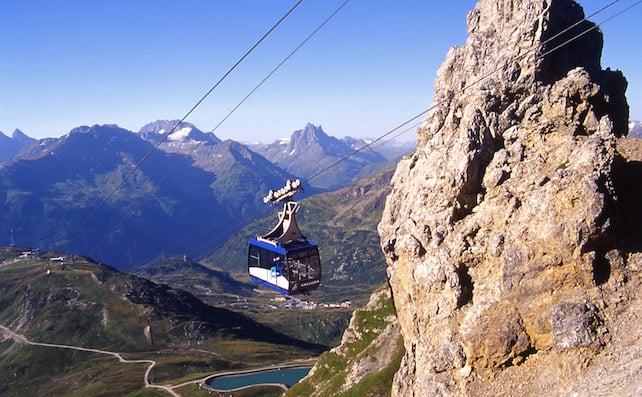
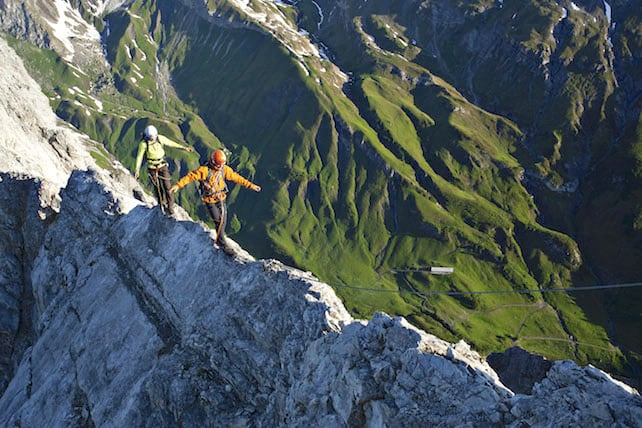
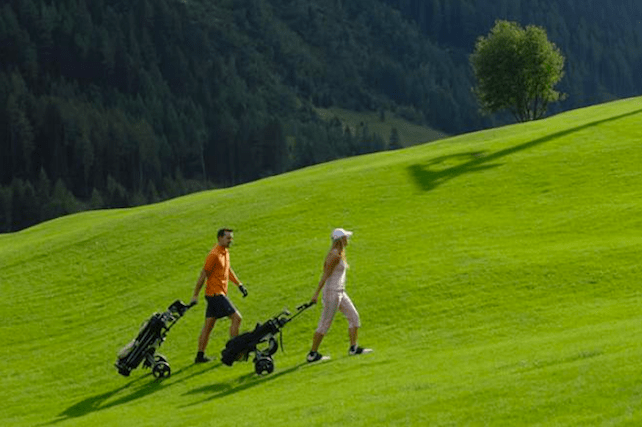
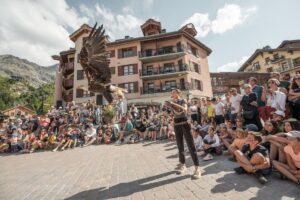
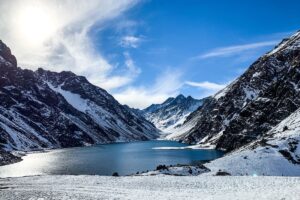
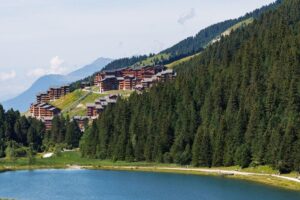
Add Comment